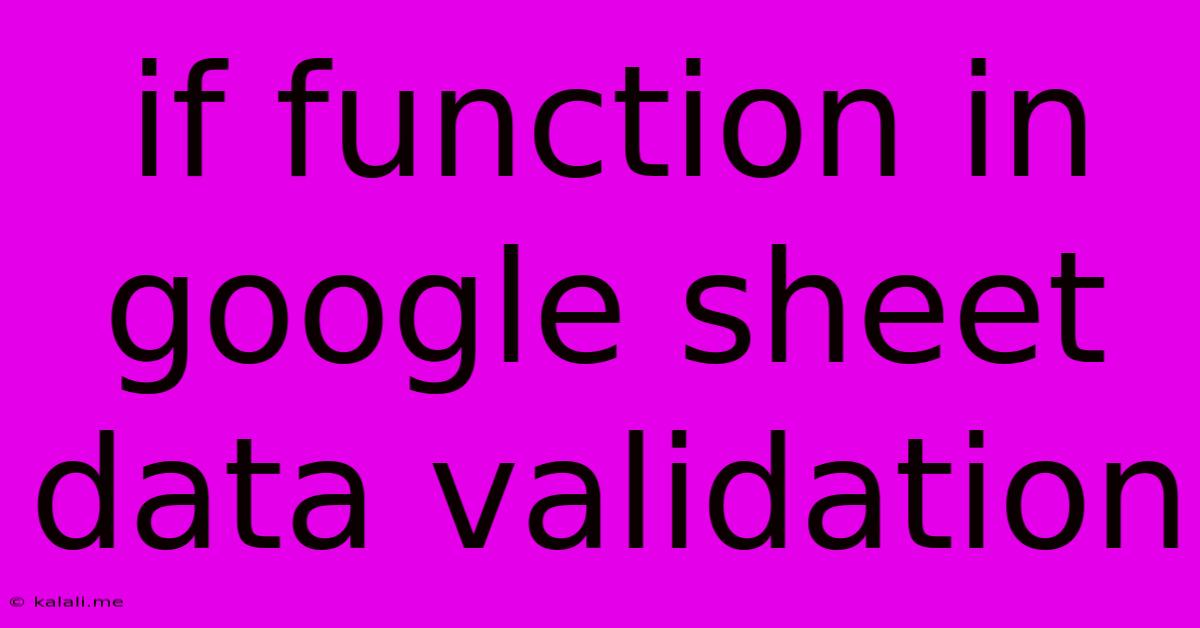If Function In Google Sheet Data Validation
Kalali
Jun 04, 2025 · 4 min read

Table of Contents
Harnessing the Power of IF Functions in Google Sheets Data Validation
Data validation in Google Sheets is a powerful tool for ensuring data accuracy and consistency. By setting rules for what kind of data can be entered into specific cells, you can prevent errors and improve the overall quality of your spreadsheet. This article dives deep into how to leverage the IF function within data validation to create even more sophisticated and dynamic rules. Learn how to use conditional logic to control what your users can input, enhancing the usability and reliability of your Google Sheets.
Understanding the Basics of Data Validation
Before diving into the IF function integration, let's quickly review the fundamental aspects of data validation in Google Sheets. Data validation allows you to restrict the type of data entered into a cell, such as numbers within a specific range, dates, text strings meeting certain criteria, or even lists of predefined values. You can also add custom error messages to guide users if they try to input invalid data. This prevents human error and ensures data integrity.
Integrating the IF Function for Conditional Validation
The true power of data validation unfolds when you combine it with functions like IF. This allows you to create dynamic validation rules that adapt based on the values in other cells. Let's explore some practical examples:
1. Dependent Dropdowns: Imagine you have a spreadsheet tracking sales by region and product. You might want a dropdown for selecting the region first, and then a second dropdown for the product that only shows products available in the selected region. This is where the IF function shines. The validation rule for the product dropdown would use the IF function to dynamically populate the list based on the region selected in the first dropdown.
=IF(A1="North", {"Product A", "Product B"}, IF(A1="South", {"Product C", "Product D"}, {"Product E"}))
This formula checks the value in cell A1 (region) and returns a different list of products based on the region selected. This is a powerful way to create interconnected and context-aware data entry. Note that the curly braces {} are crucial for defining arrays in this context.
2. Conditional Number Validation: You might want to validate a numerical input based on the value in another cell. For instance, if cell A1 contains the quantity of items ordered, you might want to ensure that the quantity entered in cell B1 is always less than or equal to the quantity in A1.
The data validation rule for B1 could use a formula like this:
=B1<=A1
This ensures that the value in B1 never exceeds the value in A1, enforcing a logical constraint.
3. Text Validation Based on Cell Content: Let's say you have a column for order status ("Pending," "Shipped," "Delivered"). You might want to restrict the input to only those three options. However, you only want the "Delivered" option to be available if another cell indicates payment has been received.
A complex formula could check this condition, enabling the "Delivered" option only under the correct circumstances. This level of control enhances the accuracy and precision of your data entry.
4. Combining IF with Other Functions: The versatility of the IF function is further enhanced when combined with other functions like ISBLANK, AND, OR, VLOOKUP, and more. This allows you to build extremely sophisticated validation rules tailored to the unique needs of your spreadsheet.
Best Practices for Using IF Functions in Data Validation
- Keep it simple: While powerful, complex
IFfunctions can become difficult to manage. Break down complicated logic into smaller, more manageable parts. - Clear error messages: Provide informative error messages to guide users when they enter invalid data.
- Test thoroughly: Always thoroughly test your data validation rules to ensure they work as intended under various scenarios.
- Consider user experience: Design your validation rules with the user in mind. Make the data entry process as intuitive and straightforward as possible.
By mastering the art of integrating IF functions into your Google Sheets data validation, you can create dynamic and robust data entry systems that minimize errors and significantly improve the overall quality and reliability of your spreadsheets. Remember to adapt these examples and principles to your specific requirements, building a tailored validation system optimized for your unique data and workflow.
Latest Posts
Latest Posts
-
Signed Pearl Harbor Childrens Book Value
Jun 06, 2025
-
Stardew Does Tiller Work In Multiplayer
Jun 06, 2025
-
I Would Be Please To Chat With You Or
Jun 06, 2025
-
Is It Safe To Make Soucemap Available In Production
Jun 06, 2025
-
Christ In Us The Hope Of Glory
Jun 06, 2025
Related Post
Thank you for visiting our website which covers about If Function In Google Sheet Data Validation . We hope the information provided has been useful to you. Feel free to contact us if you have any questions or need further assistance. See you next time and don't miss to bookmark.